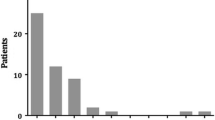Abstract
Background
Endoscopic sphincterotomy (ES) is indicated in patients with confirmed bile duct stones at endoscopic retrograde cholangiopancreatography (ERCP). The role of ES in patients with suspected bile duct stones but a normal cholangiogram, in the prevention of recurrent biliary symptoms, when cholecystectomy is not planned, is unclear.
Aim
To determine if prophylactic ES prevents further biliary problems in such patients.
Methods
Patients were identified with gallbladder stones presenting with jaundice, abnormal liver function tests (LFTs) or dilated bile ducts on ultrasound, in whom cholecystectomy was not planned and who had a normal cholangiogram at ERCP. Patients were followed-up to determine the frequency of recurrent biliary problems or repeat investigations.
Results
Forty-one patients were included, of whom 20 had an ES. The frequency of pre-ERCP features did not differ between the two groups. Median follow-up was 32 months (range 15–66). Post-ERCP recurrent abdominal pain (5 vs 3; p=0.39), jaundice (3 vs 1; p=0.28), pancreatitis (0 vs 1; p=0.32), and repeat ultrasound (2 vs 1; p=0.52), ERCP (1 vs 1; p=0.97) or cholecystectomy (2 vs 3, p=0.82) did not differ between the two groups.
Conclusions
Patients with gallstones, suspected common bile duct (CBD) stones and a normal cholangiogram need not have a prophylactic sphincterotomy since there is no reduction in recurrent biliary problems and this potentially increases the morbidity.
Similar content being viewed by others
References
Cotton PB. Endoscopic management of bile duct stones.Gut 1984; 25: 587–97.
Freeman ML, Nelson DB, Sherman S et al. Complications of endoscopic biliary sphincterotomy.N Engl J Med 1996; 335: 909–18.
Winslet MC, Neoptolemos JP. The place of endoscopy in the management of gallstones. Bailliere’s ClinicalGastroenterology 1991; 5: 99–129.
Lai ECS, Mok FPT, Tan ESY et al. Endoscopic biliary drainage for severe acute cholangitis.N Engl J Med 1992; 326: 1582–6.
Neoptolemos JP, Shaw DE, Davidson BR, Carr-Locke DL. Multivariate analysis of pre-operative risk factors in patients with common bile duct stones: implications for treatment.Ann Surg 1989; 209: 157–61.
Tham TCK, Carr-Locke DL. Endoscopic treatment of bile duct stones in elderly people.Br Med J 1999; 318: 617–8.
Welbourn CR, Beckly DE, Eyre-brook IA. Endoscopic sphincterotomy without cholecystectomy for gallstone pancreatitis.Gut 1995; 37: 119–20.
Author information
Authors and Affiliations
Corresponding author
Rights and permissions
About this article
Cite this article
Johnston, S.D., Lim, P., Collins, J.S.A. et al. Does prophylactic endoscopic sphincterotomy prevent recurrent biliary problems in patients with gallstones and a normal cholangiogram?. Ir J Med Sci 171, 197–198 (2002). https://doi.org/10.1007/BF03170279
Issue Date:
DOI: https://doi.org/10.1007/BF03170279




